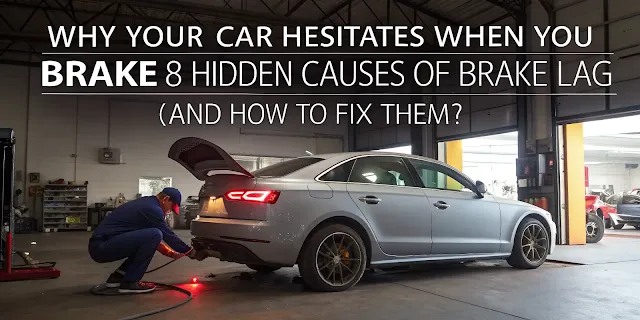Have you ever pressed your car's brake pedal only to feel a frustrating delay before your vehicle actually slows down? That uncomfortable pause is called brake lag — and it’s more common (and dangerous) than most drivers realize. Whether you're driving in city traffic or on the highway, even a split-second delay in braking can lead to accidents. In this guide, we’ll explore the 8 most common — and often hidden — causes of brake lag and show you how to fix them to restore your car’s safety and responsiveness.
Why Your Car Hesitates When You Brake: 8 Hidden Causes of Brake Lag (And How to Fix Them)
Brake lag is a delay between pressing your brake pedal and the vehicle actually slowing down. This can be extremely dangerous and increase the risk of an accident. Let’s explore what causes this lag and how you can fix it before it becomes a bigger issue.
🚨 What Is Brake Lag?
Brake lag occurs when there's a noticeable delay between the time you press the brake pedal and the time your car begins to slow or stop. It can be caused by mechanical failures, air in the brake lines, or worn-out components.
🔧 8 Most Common Causes of Brake Lag (and How to Fix Them)
1. Air in Brake Lines
This is one of the most common reasons. Air bubbles prevent fluid from transferring pressure effectively.
Fix: Bleed your brake lines to remove trapped air.2. Worn Brake Pads
Over time, brake pads lose their thickness and can no longer generate enough friction.
Fix: Replace brake pads as soon as they reach minimum thickness.3. Low or Dirty Brake Fluid
Brake fluid needs to be clean and at the proper level to function properly.
Fix: Top off or flush the fluid as recommended in your vehicle’s manual.4. Faulty Brake Calipers
Sticking or leaking calipers can delay braking action.
Fix: Repair or replace damaged calipers.5. Brake Booster Issues
A failing brake booster makes the pedal feel spongy and increases stopping time.
Fix: Replace the brake booster if found faulty.6. Vacuum Leaks
Vacuum leaks reduce the efficiency of the brake booster system.
Fix: Inspect hoses and connections; seal or replace as needed.7. Old or Contaminated Brake Fluid
Old fluid loses its hydraulic properties and can introduce corrosion.
Fix: Flush the system every 2–3 years.8. Suspension Problems
Worn shocks or struts affect the way your car responds when braking.
Fix: Replace worn suspension components for better stability.🔍 Signs You Might Be Experiencing Brake Lag
- Soft or spongy brake pedal
- Longer stopping distances
- Grinding or squealing noises
- Pulling to one side while braking
🛠️ Prevention Tips
- Inspect brake components every 6 months
- Use high-quality brake parts
- Flush brake fluid regularly
- Avoid aggressive driving habits
📚 Related Articles
🔊 Strange Noises While Shifting Gears
Discover what those grinding or clunking sounds mean when changing gears.
Read More →⚙️ Running Out of Gears
Understand why your car may feel like it’s running out of gears during acceleration.
Read More →🛠️ Periodic Maintenance: Meaning & Importance
Learn why periodic maintenance is vital to keeping your vehicle in top condition.
Read More →🚫 Car Won't Go Into Gear
Find out why your car refuses to engage gears and what to do about it.
Read More →🏍️ Motorcycle Maintenance Guide
A complete guide to keeping your motorcycle in peak shape with regular care.
Read More →🔄 Transmission System Explained
Understand how a transmission system works and why it’s crucial to your car’s performance.
Read More →✅ Final Thoughts
Brake lag should never be ignored. Timely maintenance and awareness of early warning signs can save your life. If your brakes feel off, don’t wait — get them inspected by a professional immediately.
📌 সারাংশ
ব্রেক ল্যাগ বা ব্রেক চেপে গাড়ি থামাতে দেরি হওয়া একটি গুরুতর সমস্যা। এটি সাধারণত ব্রেক লাইনে বাতাস ঢোকা, ঘষে যাওয়া ব্রেক প্যাড, ব্রেক ফ্লুইডের সমস্যা, বা ব্রেক বুস্টার ও ক্যালিপারের ত্রুটির কারণে হয়। নিয়মিত রক্ষণাবেক্ষণ এবং দ্রুত সমস্যা চিহ্নিত করে সমাধান করলেই আপনি নিরাপদভাবে গাড়ি চালাতে পারবেন।
FAQs
1. What is brake lag and why does it happen?
Brake lag is a delay between pressing the brake pedal and the actual slowing or stopping of the vehicle. It can be caused by air in the brake lines, low brake fluid, worn brake pads, or faulty brake components.
2. Is brake lag dangerous?
Yes, brake lag can be very dangerous, especially during emergency stops. It increases your stopping distance, which can lead to collisions or accidents if not addressed promptly.
3. How can I fix brake lag at home?
You can try basic fixes like bleeding the brake lines, topping up brake fluid, or replacing worn brake pads. However, for major issues like caliper or booster failure, professional help is recommended.
4. How often should I check my brake system?
It’s a good practice to inspect your brake system every 6 months or at least once a year. Regular maintenance helps prevent brake lag and ensures road safety.
5. Can dirty brake fluid cause brake lag?
Yes. Over time, brake fluid absorbs moisture and contaminants, reducing its effectiveness and leading to delayed brake response. Flushing the brake fluid every 2-3 years is recommended.
6. Why does my brake pedal feel spongy?
A spongy brake pedal usually indicates air in the brake lines or low brake fluid. It’s a common symptom of brake lag and should be addressed immediately.
7. Will replacing brake pads fix brake lag?
Yes, if the brake lag is due to worn-out pads. However, if the issue lies elsewhere (e.g., in the fluid, calipers, or booster), replacing pads alone won't solve it completely.
🔗 Trusted Sources & References
🛠️ Firestone Complete Auto Care
Title: Brake Lag Explained: Causes and What You Can Do
Visit Source →
